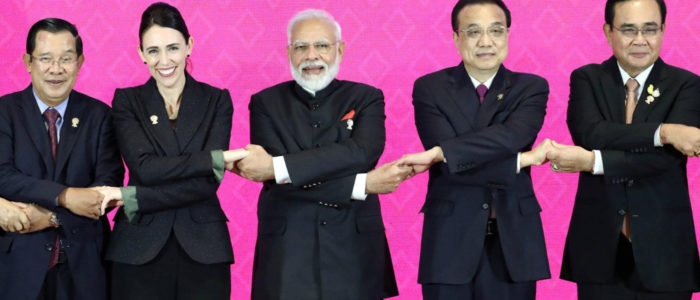Recently, India announced to stay out of the historic free trade agreement of Regional Comprehensive Economic Partnership (RCEP). This trade pact has been considered the net economic engine of Indo-Pacific region. The aspiring countries were 10 Association of South East Asian Nations (ASEAN) member states along with six largest trading partners – China, Japan, South Korea, Australia, New Zealand, and India. In India, the decision is being praised for domestic reasons while many are considering it an avoidance of regional economic integration.
On November 4, Indian Prime Minister Narendra Modi said, “…neither the talisman of Gandhi nor my own conscience permit me to join the RCEP.” The decision was welcomed by Swadeshi Jagaran Manch (SJM) and Bharatiya Kisan Sangh – affiliates of Rashtriya Swayamsevak Sangh. The co-convener of SJM Ashwani Mahajan said that this agreement would have killed Make in India, Digital India, Skill India, and various other avenues of job creation. Indian Minister of Home Affairs Amit Shah pronounced, “…it shall ensure support to our farmers, small and medium enterprises, dairy & manufacturing sector, pharmaceutical, steel & chemical industries.” The official reason for not joining appeared in the form of RCEP’s indifference toward India’s concerns regarding its agriculture and domestic industry. Generally, it is said that Indian local industry cannot compete with East Asian economies as this could result in eventual collapse of domestic industries.
The prime fear of India is trade imbalance. If India joined RCEP, that would mean elimination of tariffs on 90% products between India and ASEAN, and Japan and South Korea. On the other hand, the signing of agreement could eliminate tariffs on 74% products between China and India. Moreover, India is bearing $53 billion bilateral trade deficit with China. Therefore, joining RCEP means elimination of tariffs which further means expansion of trade deficit. Thus, India’s already slow economy cannot endure trade deficit. Additionally, Indian insecurity towards China is reflecting by her blame on China of using unfair means in bilateral trade. For instance, the accusation of India that China is using Hong Kong as a proxy in trade, that is to say China started exporting products by doing some cosmetic changes in goods. If the situation prevails, trade deficit could be $80 billion in next five years. Hence, staying out of RCEP is more beneficial for India, according to official statements.
The official reason for not joining appeared in the form of RCEP’s indifference toward India’s concerns regarding its agriculture and domestic industry.
Secondly, certain sections of Indian economy are in a cycle of comparative disadvantage due to various reasons. Among these are agriculture sector, manufacturing sector, communication, and small businesses. Agriculture sector can be undermined owing to large influx from Australia and New Zealand especially in dairy and food processing products. The eventual target of this situation could be farmers of India. By the same token, the vulnerability of manufacturing and industrial sectors is inevitable due to advancement of China and other East Asian economies.
The aforesaid apprehensions raised by the Modi government are reflecting a state of paranoia. Protectionist policies are generally made for strategic purposes not for economic advantages. The same is the case with the Indian decision of staying out of RCEP. Contextually, six out of 10 largest trading partners of India are from RCEP countries. Therefore, it would be very difficult for India to manage its huge population by putting itself in trade isolation. Even if the existing import-export ratio remains same, the trade deficit will grow because the nature of Indian economy is not based on manufacturing instead it is rather a mix of agro-industrial items.
Regional and global statecraft of economics is generating pro-China imperatives. The actualisation of Belt and Road Initiative (BRI) is going to make Indo-Pacific region the next engine of global economics. Renminbi is challenging the hegemony of dollar. Even Russia joined it despite its energy-oriented European market. India is also a part of BRICS. In the presence of these economic rationales, the more likely chance for India will be of rejoining it. In political economy, the question of export–import balance is usually tackled down by protectionist measures, not by isolation. The case of US-China trade war is highly protectionist in nature despite huge trade deficit of more than $300 billion. The option of isolation could not find its place in the existing world order where trade is the sine qua non for growth and development.
India’s decision to stay out is more driven by China factor and less by domestic reasons. India has been enjoying strategic leverage over other South Asian countries due to its huge population. Once economic integration of South Asian region is materialised, Indian leverage will be overshadowed by economic integration of Indo-Pacific region. It should be remembered that India also preferred to stay out of China-Pakistan Economic Corridor due to this very same reason. Thus, India is trying to avoid intense economic interdependence as it will engulf the whole South Asian region because of China’s penetration through BRI. India’s inclusion in economic chessboard of East Asia would make China the queen of the said chessboard. For India the game is flawed, for China the retreat is cosmetic.
